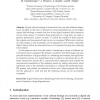145 search results - page 7 / 29 » Action Recognition Using Space-Time Shape Difference Images |
ECCV
2002
Springer
16 years 1 months ago
2002
Springer
Human activity can be described as a sequence of 3D body postures. The traditional approach to recognition and 3D reconstruction of human activity has been to track motion in 3D, m...
109
click to vote
EUROMED
2010
14 years 10 months ago
2010
Digital cultural heritage in interactive form can take different shapes. It can be either in the form of interactive virtual representations of non-digital objects like buildings o...
118
click to vote
PAMI
2011
14 years 2 months ago
2011
—We present a discriminative part-based approach for human action recognition from video sequences using motion features. Our model is based on the recently proposed hidden condi...
99
Voted
ICASSP
2011
IEEE
14 years 3 months ago
2011
IEEE
Conventional methods for rotation angle estimation are not very robust to variations in object shape or intensity. However in real object recognition scenarios like in underwater ...
101
Voted
AMFG
2003
IEEE
15 years 5 months ago
2003
IEEE
This paper provides a new fully automatic framework to analyze facial action units, the fundamental building blocks of facial expression enumerated in Paul Ekman’s Facial Action...

